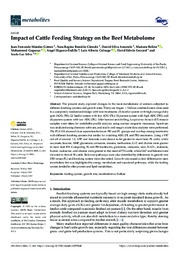Impact of cattle feeding strategy on the beef metabolome.
Impact of cattle feeding strategy on the beef metabolome.
Autoria: GÓMEZ, J. F. M.; CÔNSOLO, N. R. B.; ANTONELO, D. S.; BELINE, M.; GAGAOUA, M.; HIGUERA-PADILLA, A.; COLNAGO, L. A.; GERRARD, D. E.; SILVA, S. L.
Resumo: The present study explored changes in the meat metabolome of animals subjected to Different finishing systems and growth rates. Thirty-six Angus × Nellore crossbred steers were used in a completely randomized design with four treatments: (1) feedlot system with high average daily gain (ADG; FH); (2) feedlot system with low ADG (FL); (3) pasture system with high ADG (PH); and (4) pasture system with low ADG (PL). After harvest and chilling, Longissimus thoracis (LT) muscle samples were taken for metabolite profile analysis using nuclear magnetic resonance. Spectrum was analyzed using chenomx software, and multi- and mega-variate data analyses were performed. The PLS-DA showed clear separation between FH and PL groups and overlap among treatments with different finishing systems but similar for matching ADG (FL and PH) treatments. Using a VIP cut-off of around 1.0, ATP and fumarate were shown to be greater in meat from PL cattle, while succinate, leucine, AMP, glutamate, carnosine, inosine, methionine, G1P, and choline were greater in meat from FH. Comparing FL and PH treatments, glutamine, carnosine, urea, NAD+, malonate,lactate, isoleucine, and alanine were greater in the meat of PH cattle, while G6P and betaine were elevated in that of FL cattle. Relevant pathways were also identified by differences in growth rate (FH versus PL) and finishing system were also noted. Growth rate caused a clear difference in meat metabolism that was highlighted by energy metabolism and associated pathways, while the feeding system tended to alter protein and lipid metabolism.
Ano de publicação: 2022
Tipo de publicação: Artigo de periódico
Unidade: Embrapa Instrumentação
Palavras-chave: Feeding system, Growth rate
Observações
1 - Por padrão são exibidas publicações dos últimos 20 anos. Para encontrar publicações mais antigas, configure o filtro ano de publicação, colocando o ano a partir do qual você deseja encontrar publicações. O filtro está na coluna da esquerda na busca acima.
2 - Para ler algumas publicações da Embrapa (apenas as que estão em formato ePub), é necessário ter, no celular ou computador, um desses softwares gratuitos. Sistemas Android: Google Play Livros; IOS: iBooks; Windows e Linux: software Calibre.
Acesse outras publicações
Acesse a Base de Dados da Pesquisa Agropecuária (BDPA) para consultar o acervo completo das bibliotecas da Embrapa.

